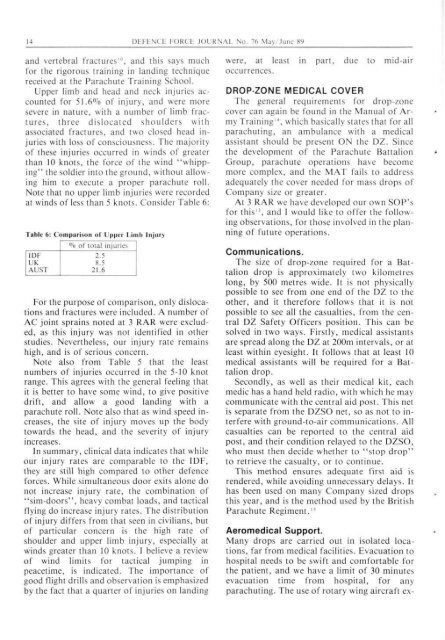ISSUE 76 : May/Jun - 1989 - Australian Defence Force Journal
ISSUE 76 : May/Jun - 1989 - Australian Defence Force Journal
ISSUE 76 : May/Jun - 1989 - Australian Defence Force Journal
- No tags were found...
Create successful ePaper yourself
Turn your PDF publications into a flip-book with our unique Google optimized e-Paper software.
14 DEFENCE FORCE JOURNAL No. <strong>76</strong> <strong>May</strong>/<strong>Jun</strong>e 89and vertebral fractures 1 ", and this says muchfor the rigorous training in landing techniquereceived at the Parachute Training School.Upper limb and head and neck injuries accountedfor 51.6°7o of injury, and were moresevere in nature, with a number of limb fractures,three dislocated shoulders withassociated fractures, and two closed head injurieswith loss of consciousness. The majorityof these injuries occurred in winds of greaterthan 10 knots, the force of the wind "whipping"the soldier into the ground, without allowinghim to execute a proper parachute roll.Note that no upper limb injuries were recordedat winds of less than 5 knots. Consider Table 6:Table 6: Comparison of Upper limb InjuryIDFUKAUST% of total injuries2.58.521.6For the purpose of comparison, only dislocationsand fractures were included. A number ofAC joint sprains noted at 3 RAR were excluded,as this injury was not identified in otherstudies. Nevertheless, our injury rate remainshigh, and is of serious concern.Note also from Table 5 that the leastnumbers of injuries occurred in the 5-10 knotrange. This agrees with the general feeling thatit is better to have some wind, to give positivedrift, and allow a good landing with aparachute roll. Note also that as wind speed increases,the site of injury moves up the bodytowards the head, and the severity of injuryincreases.In summary, clinical data indicates that whileour injury rates are comparable to the IDF,they are still high compared to other defenceforces. While simultaneous door exits alone donot increase injury rate, the combination of"sim-doors", heavy combat loads, and tacticalflying do increase injury rates. The distributionof injury differs from that seen in civilians, butof particular concern is the high rate ofshoulder and upper limb injury, especially atwinds greater than 10 knots. I believe a reviewof wind limits for tactical jumping inpeacetime, is indicated. The importance ofgood (Tight drills and observation is emphasizedby the fact that a quarter of injuries on landingwere, at least in part, due to mid-airoccurrences.DROP-ZONE MEDICAL COVERThe general requirements for drop-zonecover can again be found in the Manual of ArmyTraining 14 , which basically states that for allparachuting, an ambulance with a medicalassistant should be present ON the DZ. Sincethe development of the Parachute BattalionGroup, parachute operations have becomemore complex, and the MAT fails to addressadequately the cover needed for mass drops ofCompany size or greater.At 3 RAR we have developed our own SOP'sfor this", and I would like to offer the followingobservations, for those involved in the planningof future operations.Communications.The size of drop-zone required for a Battaliondrop is approximately two kilometreslong, by 500 metres wide. It is not physicallypossible to see from one end of the DZ to theother, and it therefore follows that it is notpossible to see all the casualties, from the centralDZ Safety Officers position. This can besolved in two ways. Firstly, medical assistantsare spread along the DZ at 200m intervals, or atleast within eyesight. It follows that at least 10medical assistants will be required for a Battaliondrop.Secondly, as well as their medical kit, eachmedic has a hand held radio, with which he maycommunicate with the central aid post. This netis separate from the DZSO net, so as not to interferewith ground-to-air communications. Allcasualties can be reported to the central aidpost, and their condition relayed to the DZSO,who must then decide whether to "stop drop"to retrieve the casualty, or to continue.This method ensures adequate first aid isrendered, while avoiding unnecessary delays. Ithas been used on many Company sized dropsthis year, and is the method used by the BritishParachute Regiment. 15Aeromedical Support.Many drops are carried out in isolated locations,far from medical facilities. Evacuation tohospital needs to be swift and comfortable forthe patient, and we have a limit of 30 minutesevacuation time from hospital, for anyparachuting. The use of rotary wing aircraft ex-
















